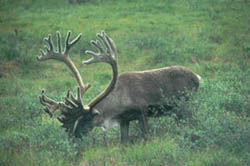
Wildlife
Nahanni National Park Reserve
Wildlife
The wildlife of Nahanni National Park Reserve is diverse for the relatively high latitude of the park. The dominant characteristic of the wildlife species in the park is their adaptation to a rugged and highly seasonal environment. The majority of species adapt by either migrating for the winter to a less severe environment, or spending the winter hibernating. Species which are year-round residents adapt by showing seasonality in their movements. The park's diversity of wildlife is best seen during the relatively short summer season.
Mammals
Birds
Reptiles and Amphibians
Fish
Searching for Bull Trout | Field Notes
Mammals
Forty-two mammal species have been recorded in the park. Although the animals themselves may be elusive, their tracks and scats are often seen.

Caribou
Both black and grizzly bears commonly occur in Nahanni, and the Rabbitkettle Lake area has been identified as seasonally important bear habitat. Wolves are found along the river valleys, and field observations suggest moose and caribou are staple prey items. Several weasel species, including wolverine, occur in the park, as do a variety of rodents and bats. Small and medium-sized mammals found in the park include shrews, voles, Arctic ground squirrels, muskrats, beaver, marmots, and snowshoe hare. Some mammalian predators are mink, marten, otter, lynx and red fox.
A number of ungulate species occupy a wide range of ecological niches in the park. Moose are the park's most common and broadly distributed ungulate. Small numbers of mountain goats can be found in a few of the alpine areas, but most of their range is outside the park boundary. Dall's sheep are commonly observed in the park, but their movements also extend well beyond the park area. A small percentage of woodland caribou are found in the park year-round. Caribou use the park most heavily in the winter. Prime calving summer habitats and autumn ruts for the woodland caribou are located farther to the northwest beyond the park boundary. Mule deer and, more recently, white-tailed deer, have been seen in eastern parts of the park. Mineral licks in Nahanni constitute an important seasonal resource for most species of ungulates.
Birds
The birds of Nahanni show an interesting diversity, with a mixture of cordilleran, boreal and great plain species. A total of 180 bird species have been documented, with 21% of these species remaining in the north year-round.
Two lakes within the park are of particular importance to aquatic birds. Yohin Lake and Rabbitkettle Lake are important habitats for breeding waterfowl. Yohin Lake supports a small nesting population of trumpeter swans. The presence of these majestic birds is of special interest because of their rarity in Canada. At Rabbitkettle Lake, one may find up to four species of loons, as well as red-necked grebes.
Sharp-shinned hawks, American kestrels and both bald and golden eagles can be seen along the South Nahanni River. Peregrine falcons and gyrfalcons have been occasionally spotted.
Reptiles and Amphibians
There are no known reptile species in the park and very few amphibians.
Wood frogs have the widest distribution throughout the north of any amphibian. They are thought to inhabit areas with early, deep snowfalls which provide a protective layer of insulation for hibernating. Studies are needed to determine the extent of amphibian ranges within the park.
Fish
Sixteen fish species have been recorded within the South Nahanni watershed: lake trout, Dolly Varden, Arctic grayling, burbot, longnose sucker, northern pike, lake whitefish, round whitefish, mountain whitefish, inconnu, slimy sculpin, lake chub, longnose dace, spoonhead sculpin, trout-perch and spottail shiner. Most of the species are found in the park, although spoonhead sculpin, trout-perch, and spottail shiner are not common.
Lake trout occur throughout the park, inhabiting deeper, less turbid standing water. They are vulnerable to overfishing due to their restricted distribution, slow growth, late maturity and limited reproductive capacity.
Dolly Varden are found in the South Nahanni River and many tributary streams above and below Virginia Falls. Young Dolly Varden hatch in the headwater streams of the watershed, and then migrate downstream into the park and beyond during adulthood.
Arctic grayling is the most common fish species found, inhabiting most small streams and larger lakes within the watershed. Like Dolly Varden, grayling hatch in the headwaters and then migrate downstream.
Because of their hatching location and migration route, Dolly Varden and Arctic grayling are particularly susceptible to overfishing as well as upstream developments that may affect their migration routes and spawning areas.
Northern pike are confined primarily to Yohin Lake and the lower South Nahanni and Flat rivers.
Searching for Bull Trout | Field Notes
- Date modified :
